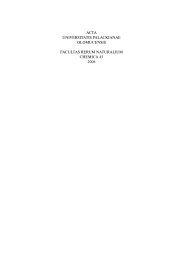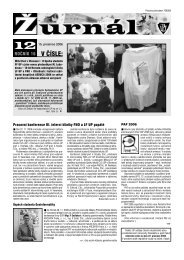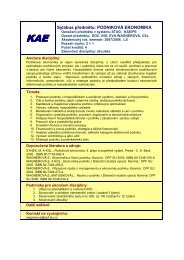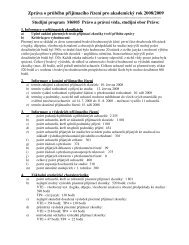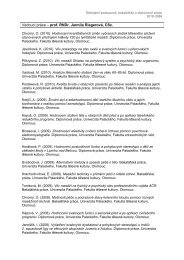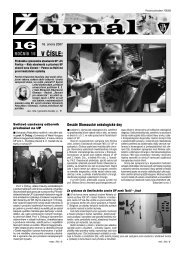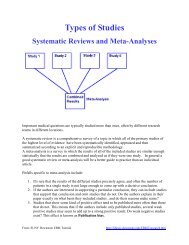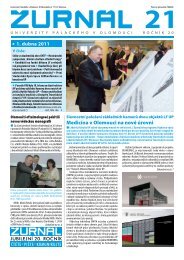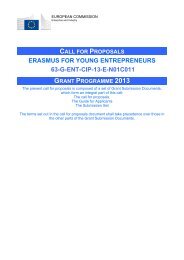ACTA UNIVERSITATIS PALACKIANAE OLOMUCENSIS GYMNICA ...
ACTA UNIVERSITATIS PALACKIANAE OLOMUCENSIS GYMNICA ...
ACTA UNIVERSITATIS PALACKIANAE OLOMUCENSIS GYMNICA ...
- No tags were found...
Create successful ePaper yourself
Turn your PDF publications into a flip-book with our unique Google optimized e-Paper software.
Acta Univ. Palacki. Olomuc., Gymn. 2004, vol. 34, no. 2 55in the LF zone and non-significant enhancement inthe HF zone, occurred. A similar reaction can befound in relative spectral powers. Similar trends canalso be found in CCVLF and CCVHF parameters.Interpretation of frequency and amplitude changesduring the use of this respiratory technique is unclear.Enhancement of activity in the dominantfrequency in the LF zone is partially influenced byvariation in individual respiratory frequency values.It is not clear why simultaneous enhancement of activityin the HF zone happens. The question raisedhere is whether partial enhancement of respiratoryresistance in upper airways during blockage of onenostril does not have any relation to increased vagusactivity.2.5 Rapid rhythmic diaphragm breathing (kapalabhaty)and spontaneous respiration (TABLE 5, Fig. 5, 6)At interval T10 as compared to the T9 interval, therewas a distinct reduction of total spectral power and asimultaneous decline of spectral power in all partialfrequency components. These changes of spectralpowers create a functional picture of a stress situation.During use of this technique of respiration shift of frequencybound on respiration frequency happened inthe sphere of frequency that is above the frequencyfield of 0.4 Hz, which is the upper frequency zoneregistered by the diagnostic system Vario TF4 andother variants of the device. Respiratory boundvagus activity is thus out of the frequency zone ofthe HF frequency component. In the zone of thisHF frequency component (0.2–0.4 Hz) we find adominant frequency that is not bound to respiratoryfrequency and its source is unclear. If we regard theHF zone as total parasympathetic activity, then itis possible to consider these frequencies in the HFzone as a source of parasympathetic activity originatingin the inner organs innervated by the nervusvagus.DISCUSSIONThe relationship between rhythmised respiratory frequencyand spontaneous respiratory frequency while lying, andobserved SAHRV changesIt is essential to regard respiratory pattern as a fundamentalfactor in modulating the actual functionalactivity of the autonomous nervous system. Rhytmisationof respiratory frequency stabilises the positionof respiratory bound frequency regarded to be a basicfunctional component linked to parasympathetic activity.We found the relationship of respiratory frequencyto respiratory bound frequency as determined by thenumeric relation RvFr (mHz) = 0.0167 (Hz) × Rf/min.described in the works of Kolisko, Salinger, Opavský etal. (1997) in the sample of examined people during theuse of a standardly rhythmised respiratory frequency of12 cycles/min. while standing and also in the lying position.Also, Brown et al. (1993) arrived at similar resultson the relationship between respiratory frequency andR-R interval fluctuation.Under these conditions we can unambiguously assessthe activity in the HF zone in the output listing ofSAHRV as total parasympathetic activity. If we regardrespiratory frequency in harmony with Paleček et al.(1999), and Ganong (1999) as an ergonomically optimalfunctional coalition of respiratory frequency, respiratoryvolume and muscle tone of the inspiratory andexpiratory muscles, we did not find during rhythmisedrespiratory frequency any significant decrease in totalspectral power that would signal rhythmised respiratoryfrequency to be perceived by the body refl ectively asa specific kind of load.At intervals with spontaneous respiration, a considerablevariability of individual respiratory frequencyoccurred within the observed sample. It is very probablethat the changes in spectral powers and in the relativespectral powers of LF and HF frequency componentsduring spontaneous respiration, when compared torhythmised respiratory frequency are modulated by theinfluence of value variability in individual respiratoryfrequency during measured intervals.The relationship between the change from the lying to thesitting position during the use of spontaneous respiratoryfrequency and the observed SAHRV changesThe change from a lying to a sitting position duringspontaneous respiration is perceived reflexively in thebody as a specific type of postural load when reductionof total spectral power and a signifi cant reduction ofactivity in the zone of the HF frequency component occurin comparison to the lying position. Since sitting isunderstoood by us to be partial orthostasis, changes inANS reactivity are not so typical compared to stan dingand lying positions. The sitting position is, however,functionally suitable for more effective engagement ofrespiratory muscles during inspiration and the facilitationof a respiratory pattern with prevailing diaphragmrespiration. Apparently for this reason, the oriental techniquesof respiratory exercises recommend sitting withcrossed legs or sitting on one’s heels as basic positionsduring autoregulative exercises emphasising an uprighttrunk position.The relationship among spontaneous respiration frequency,selected respiration techniques and observed SAHRV parametersIntensifi ed respiration with continual engagementof inspiration and expiration muscles (the so-calledtechnique of full yoga respiration) is characterised byintensifi cation of respiration volume, a decrease in



